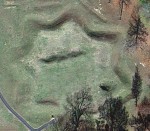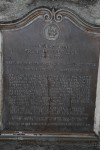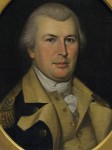 The only mine tunnel from the Revolutionary War known to survive has been opened and explored by a firefighter in the first stage of its preservation. The 125-foot tunnel was designed by Polish humanist, engineer and Revolutionary War hero Thaddeus Kosciuszko during the 1781 siege of the earthen Star Fort in the town of Ninety Six, South Carolina. The plan was for the tunnel to extend underneath the Star Fort so that it could be mined from below and blown up. British reinforcements arrived before the tunnel was finished, which is why it, unlike its more successful brethren, managed to survive the war.
The only mine tunnel from the Revolutionary War known to survive has been opened and explored by a firefighter in the first stage of its preservation. The 125-foot tunnel was designed by Polish humanist, engineer and Revolutionary War hero Thaddeus Kosciuszko during the 1781 siege of the earthen Star Fort in the town of Ninety Six, South Carolina. The plan was for the tunnel to extend underneath the Star Fort so that it could be mined from below and blown up. British reinforcements arrived before the tunnel was finished, which is why it, unlike its more successful brethren, managed to survive the war.
The earthworks of Star Fort are still in existence and the entire site is now a National Park. The Park service and experts from the University of South Florida sent Greenwood firefighter Russel Cline down into the tunnel with breathing equipment since they had no idea what kind of air quality he would encounter. He found that it was remarkably good, considering the three-and-a-half foot high tunnel is more than 230 years old. The video records that the vaulted tunnel is lined with brick and mortar which at first glance, at least, still impressively sound, a testament to Kosciuszko’s skill and attention to detail.
Now that the path has been cleared, researchers will fully map and measure the tunnel with 3D imaging, laser scanning and remote sensing technology. This will give archaeologists a detailed understanding of the tunnel’s condition, and, since the it can’t be opened to the general public for its own good and ours, it will allow researchers to create 3D models to bring the tunnel to life for park visitors.
 The village of Ninety Six (the origin of the name has been lost in the mists of time) played a significant role in the Revolution. A frontier town in western South Carolina, Ninety Six was the site of several battles of the Anglo-Cherokee War (1758–1761), when the Cherokee fought against the British during the French and Indian War. Its strategic importance was undiminished 15 years later when Revolution came. In 1775, Ninety Six was the site of the first Revolutionary War battle south of New England. The year after that a casualty of another battle fought in Ninety Six claimed another first. Francis Salvador, a recent immigrant from London, prominent landowner and the first Jew to hold elected office in what would become the United States, was shot three times at the Battle of Twelve Mile Creek on August 1, 1776. Before the American militia could rescue Salvador from the battlefield, the Loyalists’ Cherokee allies scalped him. He was the only one to receive this treatment, and he died from his wounds a few hours later making Francis Salvador the first Patriot Jew to die in the Revolutionary War.
The village of Ninety Six (the origin of the name has been lost in the mists of time) played a significant role in the Revolution. A frontier town in western South Carolina, Ninety Six was the site of several battles of the Anglo-Cherokee War (1758–1761), when the Cherokee fought against the British during the French and Indian War. Its strategic importance was undiminished 15 years later when Revolution came. In 1775, Ninety Six was the site of the first Revolutionary War battle south of New England. The year after that a casualty of another battle fought in Ninety Six claimed another first. Francis Salvador, a recent immigrant from London, prominent landowner and the first Jew to hold elected office in what would become the United States, was shot three times at the Battle of Twelve Mile Creek on August 1, 1776. Before the American militia could rescue Salvador from the battlefield, the Loyalists’ Cherokee allies scalped him. He was the only one to receive this treatment, and he died from his wounds a few hours later making Francis Salvador the first Patriot Jew to die in the Revolutionary War.
In 1780, the British army — in this case experienced Loyalist troops organized into regular army regiments rather than militias — decided to fortify Ninety Six. The Provincial regiments and their slaves built a fort in the shape of an eight-point star, with earthen walls 14 feet high. Two stockade walls would keep attackers busy to give the 550 troops under the command of Lieutenant Colonel John Cruger the chance to defend.
 On May 22nd, 1781, Patriot Major General Nathanael Greene laid siege to the Star Fort. He had almost twice the number of troops and Colonel Kosciuszko on his side, but Star Fort proved a tough nut to crack nonetheless. The siege lasted 28 days, the longest siege of the Revolutionary War. First the Patriots dug an approach trench, but te defenders attacked during the construction giving Kosciuszko the only wound he ever experienced in the seven years he fought for the Patriot side: a bayonet to the buttocks.
On May 22nd, 1781, Patriot Major General Nathanael Greene laid siege to the Star Fort. He had almost twice the number of troops and Colonel Kosciuszko on his side, but Star Fort proved a tough nut to crack nonetheless. The siege lasted 28 days, the longest siege of the Revolutionary War. First the Patriots dug an approach trench, but te defenders attacked during the construction giving Kosciuszko the only wound he ever experienced in the seven years he fought for the Patriot side: a bayonet to the buttocks.
 Next Kosciuszko built a Maham Tower, a 30-foot-high siege tower with a covered platform at the top. From that height, sharpshooters could pick off the fort’s defenders, but not for long. Cruger had sandbags stacked above the parapet, protecting his troops from the sharpshooters. When the Greene’s troops tried shooting flaming arrows into the fort to set it on fire, Cruger had all the roofs removed from the buildings inside the fort making it hard for anything to catch fire.
Next Kosciuszko built a Maham Tower, a 30-foot-high siege tower with a covered platform at the top. From that height, sharpshooters could pick off the fort’s defenders, but not for long. Cruger had sandbags stacked above the parapet, protecting his troops from the sharpshooters. When the Greene’s troops tried shooting flaming arrows into the fort to set it on fire, Cruger had all the roofs removed from the buildings inside the fort making it hard for anything to catch fire.
The mine tunnel was Kosciuszko’s last engineering attempt to win the siege. It stopped short when news that 2,000 British troops were marching to Ninety Six from Charleston. On June 18th, tried a frontal assault on the fort. They reached the sandbags before they were outflanked on both sides by Cruger’s men and retreated to the trenches. With the British reinforcements just 30 miles away and having lost 150 troops in the assault, Greene ordered a full retreat.
I translated this article in romanian and putted on http://www.nationalisti.ro
Would be nice to have seen the pictures on the video showing the tunnel. I just saw a green screen.
I played on this fort as a child as it was owned by a friend of the family. I remember there being two tunnels. This would make sense, if one was discovered and destroyed, there was another to fall back on without wasting the time to dig a second tunnel. These tunnels were not brick lined originally. I think this was done to preserve them by someone at a later date. Also, I remember grates had been welded over the tunnel openings to prevent people from getting into them. When the park service obtained the site, they covered up the tunnels, and made no reference to their existence.
The name “Ninety Six” comes from the fact that it is located 96 miles from Keowee, one of the Cherokee villages near Clemson, SC. which is now underwater. 96 was on the main trading trail from Charleston to Keowee. As you approach Clemson you cross Six and Twenty Creek and Six Mile Creek, other landmarks on this long trip.
When the Park Service obtained the property, they considered it the best preserved un-restored Revolutionary War site that they had seen.
Joe Ashley
Wherever there is fighting for freedom there are the Poles. Just read a book in which the British RAF pilots & crew played a part, Blood on the Tongue. Funny how countries change sides over time. Just proves that WAR is stupid and so are the politicians who instigate it.